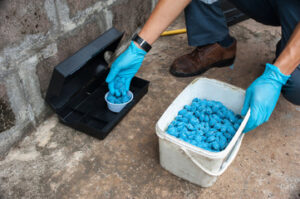Bed Bug Control Boise infestations can cause sleep deprivation and anxiety. They can also have serious health consequences.
A trained pest control professional must conduct a thorough inspection of the affected area to identify hiding spots, determine the severity of the problem, and plan the appropriate professional treatment strategy.

Reduce clutter to minimize hiding places. Vacuum and clean interceptor traps (if applicable) weekly.
Pesticides
There are a variety of chemicals that can be used to treat bed bugs. Some are based on plant materials like pyrethrins or pyrethroids that come from chrysanthemum flowers, and others have been created synthetically. Some chemicals can be toxic to people and pets, so always follow label instructions for proper application. Typically, a Do It Yourself treatment will include the use of a product sprayed on the mattress, a product sprayed on crevices and cracks other than the mattress, and a powder or dust that can be sprinkled around electrical outlets and in hard-to-reach places.
Sprays are the most common way to kill bed bugs, but they must be directed at the pests and reapplied after the area has dried. They are effective on adult bed bugs but do not kill eggs. This type of treatment can take a few days to a week to work, depending on the amount of resistance the bed bugs have built up.
A few different types of sprays are available for treating bed bugs, including pyrethroid sprays and neonicotinoids. These products are absorbed through the skin of the pest and overstimulate the central nervous system, leading to paralysis and eventually death. However, these types of sprays can be more toxic to humans and pets and should only be used by a professional who is familiar with the chemicals and their applications.
Foggers or bug bombs can also be applied to a room to kill bed bugs, but they are not considered very effective and can have dangerous side effects. Several explosions and house fires have been caused by these types of products, and they can spread the bed bugs around the home.
Another option is to use insecticide strips that contain the organophosphate dichlorvos (DDVP) or permethrin. These can be placed on items that cannot be laundered, such as luggage, pillows, and books. They release odorless vapors over time that are deadly to the bed bugs and other insects.
There are other types of chemicals that can be used, but they require special equipment and are best left to a licensed pest control company. There are also non-chemical treatments that can be done by a professional, such as steaming or freezing (Cryonite treatment).
Foggers or Bug Bombs
Foggers or bug bombs work by filling the air with chemicals that quickly kill any bugs that happen to be out in the open when they’re released. These devices are often recommended in homes with an infestation of fleas, bed bugs, cockroaches, and other pests. On their packaging, they promise a one and done experience that will leave your home pest-free.
Unfortunately, foggers do not kill a large enough proportion of pests to effectively treat an infestation, and they can actually make the problem worse. This is because the chemicals do not reach all surfaces in your home, and they cannot be aimed at key hiding places, such as cracks in baseboards or furniture. The toxic residue lands on surfaces that are frequently used by humans and pets, including floors, countertops, cabinets, and toys.
Additionally, the chemicals in foggers can also irritate the nose and throat, making breathing difficult, and causing symptoms of asthma or other respiratory conditions. They are especially dangerous for young children and infants who spend a lot of time near the ground and may put items in their mouths. If the chemical comes into contact with your eyes, it can cause severe eye damage.
The fumes from foggers can also spread to other parts of your home through the ventilation system, exposing children and pets to toxic residue. There have been numerous house fires caused by foggers when they are used in conjunction with pilot lights on stoves and furnaces. Foggers can also trigger an explosion if they are set off in close proximity to fireworks or other flammable materials.
Rather than using these risky products, there are many other effective and non-toxic methods for North Vancouver homeowners to consider. High heat can kill these insects in mattresses and other key areas in just 30 minutes. Alternatively, extreme cold can also kill them and their eggs in just five days. Wash all affected linens and clothes in hot water, and put them in the dryer on the highest setting. Any furniture that can’t be cleaned should be thrown away, and any items you do decide to keep should be clearly labeled with ‘bed bugs’ so they don’t infest another home.
Plant Oil-Based Products
As bed bugs have become resistant to many synthetic pesticides, a number of people are turning to natural products such as plant oils in an effort to control them. While these products can be effective, they must be used properly and in conjunction with other treatment methods. Before using any natural product, you should consult a professional pest control company. They can use stronger insecticides than what is available to consumers, and they can treat areas that are hard to reach with consumer-available treatments.
Plant essential oils have gained popularity in recent years for their sensory properties and alleged health benefits. Some have also been used as green pesticides, but little research has been done to determine how they work against insects, including bed bugs. This makes it difficult to understand how or why they might work.
One study screened 18 essential oils, three silicone oil, and paraffin oil against common and tropical bed bugs (Cimex lectularius and C. hemipterus). Although all oils were toxic to bed bugs, the results varied greatly from oil to oil. The researchers attributed this to the fact that essential oils have variable chemical structures and may work in different ways against bed bugs.
Other studies have tested the effectiveness of cedarwood essential oils, geraniol, and EcoRaider, a commercial product combining both ingredients. The researchers found that in direct spray tests, all oils caused some level of mortality, but only thyme and oregano oil were able to achieve the levels of efficacy needed to be effective against bed bugs. The researchers believe that combining these oils with inert carriers, surfactants, and adjuvants can help to reduce the odor issues while increasing the effectiveness of the product against bed bugs.
These products can be difficult to use properly, especially if you are not familiar with their safety and handling requirements. In addition, the odors of these oils can be overwhelming for some people. Another issue with these products is that they often evaporate quickly, so it can be hard to know how much you need to apply.
If you decide to use these products, be sure to thoroughly clean and vacuum the entire room, concentrating on the cracks and crevices where bed bugs like to hide. If possible, wash all bedding and clothing in hot water (above 120 degrees) to kill the bugs and their eggs. If you cannot launder items, purchase protective covers that will seal mattresses and box springs. If you need to dispose of infested furniture, wrap it tightly in plastic and place it in a trash container that is located outside your home.
Heat Treatment
Bed bug heat treatment is a safe and effective way to completely eradicate a home or business’s infestation of bed bugs. This method of pest control involves raising the temperature in a dwelling to above 118 degrees Fahrenheit for at least 90 minutes. This thermal death point kills all stages of the bed bug life cycle, including eggs. However, this is only a successful treatment if the entire dwelling reaches this temperature for the full duration of the process.
The cost associated with a bed bug heat treatment will depend on the size of the dwelling and the amount of infested items that need to be treated. Heavy infestations will typically require multiple rooms to be treated versus lighter ones that only need a few.
Prior to a heat treatment, all items that can be moved should be emptied of their contents and placed in hot boxes that are approved for this purpose. This will ensure that loose belongings are not pushed into spaces where they may survive the lethal temperatures of a heat treatment. If a bed bug is able to escape to areas that are not being heated, it will continue to thrive after the treatment and the problem will likely return.
All upholstered furniture in the home should be loosened of their covers and thoroughly inspected for bed bugs, fecal matter, blood spots, skin molts and eggs. It is essential to be able to find these signs of the pests as they can be hiding in the tightest of crevices. It is also recommended that you use silicon caulk to seal any small cracks or crevices where the pests are able to hide in between your home’s structure and its furniture.
It is also important to remove all clothing from dresser drawers and create openings in hanging items like shoes and purses so that the heat can permeate all of the space within. Decorative items like picture frames, personal artifacts and other objects should be removed from the home and placed into airtight containers or plastic bags to prevent them from being melted by the intense heat of the heat treatment.






